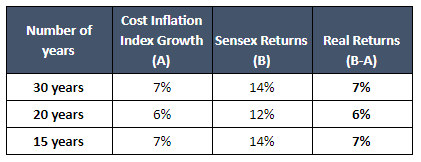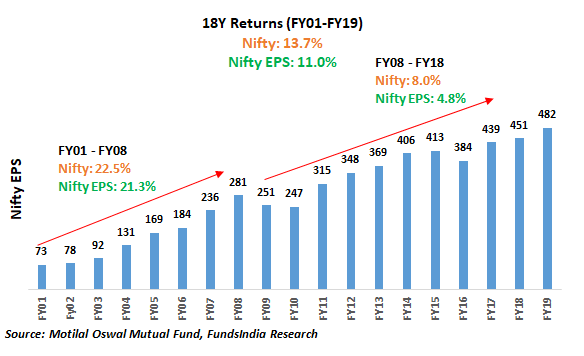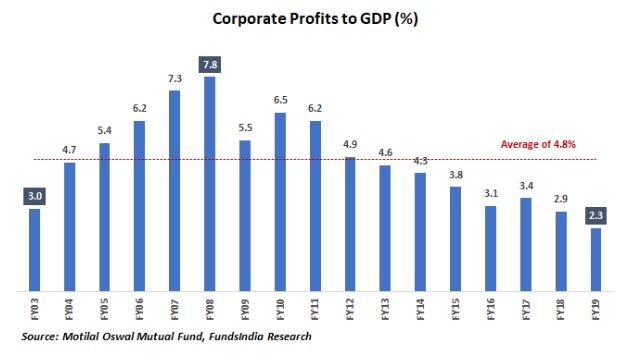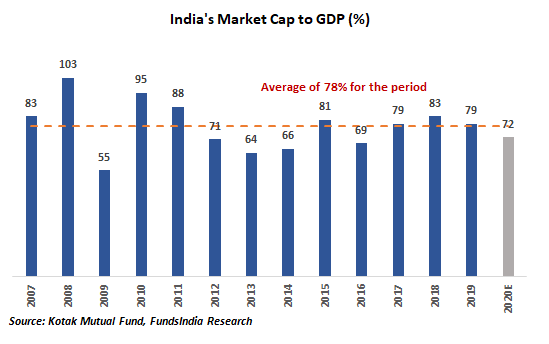Usually, this genre of headlines gets extremely popular during the final phase of a bull market before it eventually fizzles out. And in later years, this normally becomes part of the blogging folklore on how euphoric ‘magazine and newspaper headlines’ ironically predicted the peak of the bull market.
Now before you get worried that this is a classic contrarian signal for the market top, relax. This particular headline has a completely different context.
Read on to find out what’s the context behind Sensex at 1 lakh..
Stay in equities for the long term… Yawn
The message that you must ‘stay invested in equities for the long term and ignore short term declines’ has been beaten to death.
Several million articles have already been written on this.
And yet…
Long Term Equity Investors still remain a rare breed.
Have you ever wondered why it is so difficult to stay invested in equities for the long run?
All of us, thanks to our evolutionary roots, are wired to prioritize short term over the long term. So it is never easy for us to endure short term pain for long term gain.
Fair enough.
But how come when it comes to Gold or Real estate we are able to hold on for several decades.
While the prices are obviously not as volatile as equities, there are still long intermittent periods of poor returns. Yet the majority of us comfortably hang on for decades.
Maybe the secret to long-term investing has been hiding in plain sight, after all.
The secret to long-term investing
Why do you think the same ‘YOU’ is able to pull off long-term investing in real estate and gold but not in equities?
The simple answer is: FAITH
Unwavering Faith in the belief that Gold and Real Estate will do well over the long run!
And when it comes to Equities, this is exactly where the root of the problem lies.
Lack of faith in Equities for the long term.
Whenever the market declines (which you should expect on a regular basis), your conviction on Indian entrepreneurship (read as equities) is put to test.
A month back, it was US-Iran. Today, it is the Corona Virus. Tomorrow, there will be a different event to worry about. The only certainty is that equity markets will always remain uncertain and volatile in the near term with investors worrying about something or the other at all points in time.
Unless you get this basic ingredient called faith in place, it is impossible for you to stick to equities during a bad market.
The million-dollar question – How do you get this faith in equities?
If you really think about it, Equity investing for the long term finally boils down to your belief in human progress and entrepreneurship. You are simply betting that entrepreneurs (who take a higher risk) on aggregate will get compensated with higher returns in the long run.
Sounds logical. But where is the evidence?

As per the Credit Suisse Global Investment Returns Year Book 2019 (link) which looks at the past 118 years of equity returns across different countries, equity real returns (read as returns after adjusting for inflation) has been around 4-6% for most countries.
Does it work in India?

Source: www.incometaxindia.gov.in, MFI Explorer, FundsIndia Research
For Indian equities, over the long run, equity real returns (read as returns after adjusting for inflation) have been around 6-7%.
Now that we have shown you the proof, are you ready to convert to a “long term equity investor”?
If only life was so easy.
When it suddenly comes to dealing with emotions of watching your life savings decline each and every day in front of your eyes with no clue on when it will end, it is a different experience altogether. When your heightened emotions (via fear of losing it all) meets logic (of long term returns), you know by now, what will trump.
While I don’t promise to have a solution to make the emotional pain go away, here is a simple framing which I personally find useful to stay sane, especially when the markets are declining.
Sensex at 1 lakh
Faith in the belief that equities will go up, in the long run, is the most critical ingredient needed for overlooking the near term declines and sticking to equities over the long run.
So far so good.
However, Equities will go up in the long run, is, unfortunately, a very vague statement.
What if we make it more specific?.
While we are not predicting returns here, assuming a real return of 4-7% for equities as seen from global and Indian evidence, we can work out a rough return expectation of around 10-12% for equities over the next 10 years (at ~5 to 6% future inflation expectation).
Currently, the Sensex (as on 03-Feb-20) is close to 40,000.
When will the Sensex reach @1,00,000?
- @10% return expectation: In 2030
- @12% return expectation: In 2028
Some factors which support this expectation:
1.Returns over the long run mirror earnings growth
As seen below, in the long run, the market returns closely track the earnings growth.

2. Profit Growth to be much better over the next decade led by mean reversion in corporate profitability
India’s corporate profit to GDP ratio has declined from 7.8% to 2.3% – a 15 year low. We expect mean reversion to lead to above-average earnings growth (higher than Nominal GDP growth) over the next decade.

3. Current Valuations for broader market close to long term averages (except for select pockets)

Now if you buy the above argument, all you need to remember is this:
The Sensex most likely will cross 1 lakh by 2028 to 2030
So, how does this simple change in framing make a big difference?
Let us assume the market starts to fall and say reaches 32,000
Usually, the focus is on predicting the future path of the event which caused the fall. The events may range from – elections, oil prices, debt crisis, subprime, demonetization, US Iran, US-China conflict, Fed taper, Currency crisis, Dot com bubble, etc.
We know that predicting the markets and the event causing the fall consistently is next to impossible.
So what if we instead shift the focus to the Sensex at 1 lakh number.
As you anchor to the 1,00,000 number, what seemed like a crisis suddenly looks like an opportunity.
Mentally, you start thinking that “If I invest now I can look at tripling my money by 2028-30”
You get the drift…
Every time there is a correction, the human mind usually extrapolates a further fall and looks for a lower index value. But now, with this new 1 lakh anchor, you can start viewing these lower index levels as opportunities instead. In fact, in line with our “few good decisions is all it takes” motto, to prevent possible decision paralysis you can decide on pre-decided index levels where you may want to take a decision of increasing equity exposure.
The whole idea is to keep a relevant anchor point (mirroring the faith that equities will do well over the long run) which will help us keep the focus on the long term despite the several short term distractions.
Now, while it will be too naive on our part to assume that this single behavioural nudge can suddenly transform all of us into long term investors, the endeavor is to keep adding similar behavioural aids to your tool kit.
As the tool kit improves and expands, our attempt is to make your long term equity investing journey and experience as comfortable as possible.
Happy Investing as always 🙂
Please Note: The above framing is more relevant for investors with equity portfolios spread across good diversified equity mutual funds with long term track records. For a list of such funds, please check out FundsIndia’s list of select funds. This framing may not be applicable to individual stock pickers.
This article was originally published on MoneyControl. Click here to read it.







